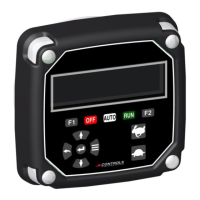
Do you have a question about the Controls MX Series and is the answer not in the manual?
| Brand | Controls |
|---|---|
| Model | MX Series |
| Category | Control Unit |
| Language | English |
Guidelines for properly positioning the control panel to ensure longevity and ease of use.
Procedure for powering on the control module, including display initialization and verification.
Description of the module's state after powering down the engine or the system.
Instructions for initiating engine start sequence using the RUN button and related display messages.
Control of engine speed via J1939 TSC1, including requested speed adjustments using up/down arrows.
Description of the 3.2" OLED display with 256x64 resolution, known for readability and wide temperature range.
Defines the display into 10 sections, numbered 1-8 for parameters, 9 for annunciation, and 10 for the clock.
ECU's primary control over engine operation, handling tolerance and taking actions like derating or shutdown.
The control panel has many options that can be configured, enabled or selected that will enhance the operation of the equipment.
The control panel can be programmed to customize the initial display screen when powered up.
The control panel can detect when a local sender for a parameter is not present, indicating dashes on display.
MX Series modules offer high configurability for auto start applications via digital input, Modbus, CANbus, or scheduler.
Basic level control using a single float device with contact closure for applications without critical start/stop points.
More precise level control using two floats (low and high limits) for stringent requirements or turbulent fluids.
Guidelines for using transducers with analog channels for pump inlet and outlet pressure monitoring.
Allows viewing trouble codes generated by the engine's ECU, typically indicated by a yellow warning lamp.
The module stores the engine's ECU fault codes, allowing users to view and clear them.
Overview of the two available methods for programming the control panel: onboard menu or PC-based CI Station.
Details on the CI Station kit, including its components and use for saving and reusing configurations.
Screen for entering a password to enable configuration changes; navigation is possible without one.
